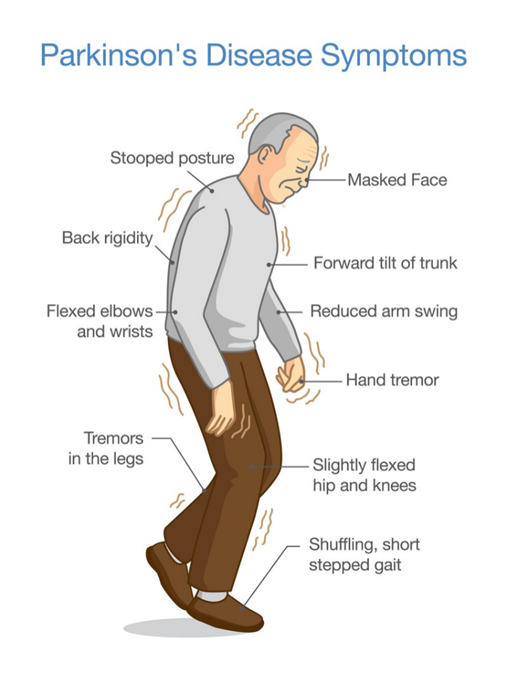A nurse is collecting data from a client who has Parkinson's disease and is experiencing bradykinesia. Which of the following findings should the nurse expect?
Increased blinking
States of euphoria
Slurred speech
Decreased respiratory rate
The Correct Answer is C
A. Increased blinking
Increased blinking is not a typical manifestation of bradykinesia. In fact, individuals with Parkinson's disease may experience reduced blinking (hypokinesia of blinking) rather than increased blinking.
B. States of euphoria
Euphoria is not typically associated with bradykinesia. Instead, individuals with Parkinson's disease may experience a range of mood changes, including depression, anxiety, or apathy, but euphoria is not a common finding.
C. Slurred speech
This is the correct answer. Slurred speech, or dysarthria, can occur in individuals with Parkinson's disease as a result of bradykinesia affecting the muscles involved in speech production. Bradykinesia can cause a reduction in the speed and coordination of movements necessary for clear speech, resulting in slurred or mumbled speech patterns.
D. Decreased respiratory rate
Decreased respiratory rate is not typically associated with bradykinesia. Bradykinesia primarily affects voluntary movements rather than involuntary processes such as respiration. While respiratory muscle weakness can occur in advanced stages of Parkinson's disease, it is not directly related to bradykinesia.

Nursing Test Bank
Naxlex Comprehensive Predictor Exams
Related Questions
Correct Answer is A
Explanation
A. The client should maintain systolic BP between 120 and 129 mm Hg.
This is an appropriate recommendation. The American Heart Association (AHA) guidelines recommend maintaining systolic BP below 130 mm Hg to reduce the risk of stroke and other cardiovascular events in individuals with a history of stroke or TIA.
B. The client should maintain systolic BP between 130 and 135 mm Hg.
This is slightly above the recommended range. While systolic BP below 135 mm Hg is generally recommended for individuals with a history of stroke or TIA, a range of 130-135 mm Hg may still be acceptable based on individual patient factors and risk assessments.
C. The client should maintain systolic BP between 136 and 140 mm Hg.
This is above the recommended range. Systolic BP between 136 and 140 mm Hg may be considered elevated and should be managed to lower levels to reduce the risk of recurrent TIA or stroke.
D. The client should maintain systolic BP between 141 and 145 mm Hg.
This is above the recommended range. Systolic BP above 140 mm Hg is generally considered elevated and should be managed to lower levels to reduce the risk of recurrent TIA or stroke.
Correct Answer is ["A","B","D"]
Explanation
A. Provide a suction setup at the bedside:
This is a relevant intervention as it ensures that suction equipment is readily available in case the client experiences excessive secretions or vomiting during or after a seizure. It helps maintain a clear airway and prevent aspiration.
B. Elevate the side rails when in bed:
Elevating the side rails can help ensure the client's safety during a seizure by preventing falls from the bed. It is a preventive measure to minimize the risk of injury.
C. Place a bite stick at the bedside:
Placing a bite stick at the bedside is not a recommended intervention. Bite sticks can potentially injure the patient's teeth or mouth during a seizure and are generally not recommended in current practice.
D. Keep an oxygen setup at the bedside:
This is an appropriate intervention as it ensures that oxygen is readily available in case the client experiences respiratory distress or hypoxia during or after a seizure. Oxygen therapy may be needed to support respiratory function.
E. Furnish restraints at the bedside:
Furnishing restraints at the bedside is not a recommended intervention for managing seizures. Restraints should only be used in exceptional circumstances when the client's safety or the safety of others is at risk and should be applied according to institutional policies and legal regulations.
Whether you are a student looking to ace your exams or a practicing nurse seeking to enhance your expertise , our nursing education contents will empower you with the confidence and competence to make a difference in the lives of patients and become a respected leader in the healthcare field.
Visit Naxlex, invest in your future and unlock endless possibilities with our unparalleled nursing education contents today
Report Wrong Answer on the Current Question
Do you disagree with the answer? If yes, what is your expected answer? Explain.
Kindly be descriptive with the issue you are facing.
